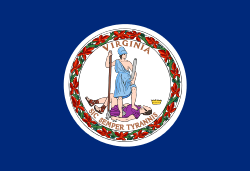Swift Creek Rail Bridge
The Tidewater and Western Railroad included a bridge over Swift Creek that had been built by earlier railroad companies. The Swift Creek Rail Bridge was a Granite and Iron Truss Bridge over Swift Creek. The Bridge was used during the whole time the four railroad companies operated rails over the bridge. The metal on the bridge was sold of as part of foreclosure of the final company in 1917.
| Railroad Bridge over Swift Creek | |
|---|---|
 Western Abutment of the Bright Hope Railroad Bridge over Swift Creek | |
| Coordinates | 37°21′01″N 77°30′41″W / 37.3502°N 77.5113°WCoordinates: 37°21′01″N 77°30′41″W / 37.3502°N 77.5113°W |
| Carries | Steam locomotives. |
| Crosses | Swift Creek (Virginia) |
| Locale | Chesterfield County, Virginia |
| Owner | Clover Hill Railroad, Brighthope Railway, Farmville and Powhatan Railroad,and then Tidewater and Western Railroad |
| Characteristics | |
| Design | Truss bridge |
| Material | Granite |
| Width | 20 ft. |
| Number of spans | 1 |
| Number of lanes | 1 |
| Rail characteristics | |
| Track gauge | Standard, 3 ft (914 mm) after 1881 |
| History | |
| Construction end | c.1841 |
| Closed | 1917 |
| Statistics | |
| Daily traffic | 2 Passenger or passenger and freight trains each way six days a week. Up to six coal trains each way daily. |
|
The Clover Hill Railroad over Swift Creek is shown in southern Chesterfield, Virginia, on a map drawn by the Confederate Army for 1861. | |
Geography and Settings
The Swift Creek Rail Bridge in Chesterfield County, Virginia cross Swift Creek, one of the two major creeks in the County. The Bridge crosses the creek, near modern day Beach and Nash Road, now hidden in the woods behind a housing development and a Landfill. The creek is narrow, because this point is west, upstream, of the fall line and the creek is not tidal here.
Architecture

The remains of the bridge are granite abutments that are twenty feet wide indicating that it was a Truss Bridge. The bridge was one span. The abutments were made of granite that was mined using star drills as shown by the drill holes. The Petersburg granite is readily available in the area.
History
The Swift Creek Rail Bridge was owned by four railroads.
Clover Hill Railroad
The bridge was constructed for the Clover Hill Railroad and Mining Company to get coal trains over Swift Creek in 1841. The tracks were standard gauge at that time. The State of Virginia declared this bridge sound in 1878.[1][2]
Brighthope Railway
The Brighthope Railway bought the Clover Hill in bankruptcy and became the new owners of the bridge in 1877. The new owners increased passenger travel. In, 1881, the Brighthope owners converted the gauge to narrow gauge.[3]
Farmville and Powhatan Railroad
The Farmville and Powhatan Railroad became the new owners in 1884. The Farmville and Powhatan allowed a telegraph to be added to the rails, which would have had a powered telegraph line across the bridge.
Tidewater and Western Railroad
The Tidewater and Western Railroad bought the bankrupt Farmville and Powhatan in 1905 and went bankrupt themselves in 1917. Creditors sold the rails and other assets to the World War One Effort in France. Only the granite Abutments remain today.Another Bridge takes Beach Road across Swift Creek. A residential road named Bright Hope is nearby.
See also
-
 Bridges portal
Bridges portal -
 Virginia portal
Virginia portal
References
- ↑ Virginia. Railroad Commissioner (1878). Annual Report of the Railroad Commissioner of the State of Virginia. R.F. Walker, superintendent public printing. pp. 70–.
- ↑ Virginia. State Corporation Commission (1917). Annual Report of the State Corporation Commission of Virginia: Compilations from Returns of Railroads, Canals, Electric Railways and Other Corporate Companies. J.H. O'Bannon, Superintendent of Public Printing. pp. 973–.
- ↑ George Woodman Hilton (1990). American Narrow Gauge Railroads. Stanford University Press. pp. 543–. ISBN 978-0-8047-1731-1.
